Clay Lead Enrichment: Complete 2025 Guide & Top Alternatives
How Clay stacks up against rivals — and which tools actually move the needle for GTM teams
Blogby JanAugust 14, 2025

Intelligent lead enrichment has become the cornerstone of successful B2B sales operations in 2025. With 61% of marketers identifying lead generation as their biggest challenge, the pressure to turn raw contact data into actionable sales intelligence has never been higher.
Clay has positioned itself as a leading solution in this space, promising to modernize how GTM teams approach lead enrichment through its platform and multi-source data aggregation. But does it deliver on these promises? And what alternatives might better serve your specific needs?
After analyzing dozens of lead enrichment platforms, testing workflows across multiple tools, and evaluating performance data, we've assembled this guide to help you navigate the evolving landscape of Clay lead enrichment solutions in 2025.
What Makes Clay's Approach Different
Clay built its reputation on a simple but powerful premise: why settle for data from one provider when you can access them all? Their lead enrichment approach centers around what they call "waterfall enrichment" – a systematic method of checking multiple data sources sequentially until complete prospect profiles emerge.
The Waterfall Method Explained
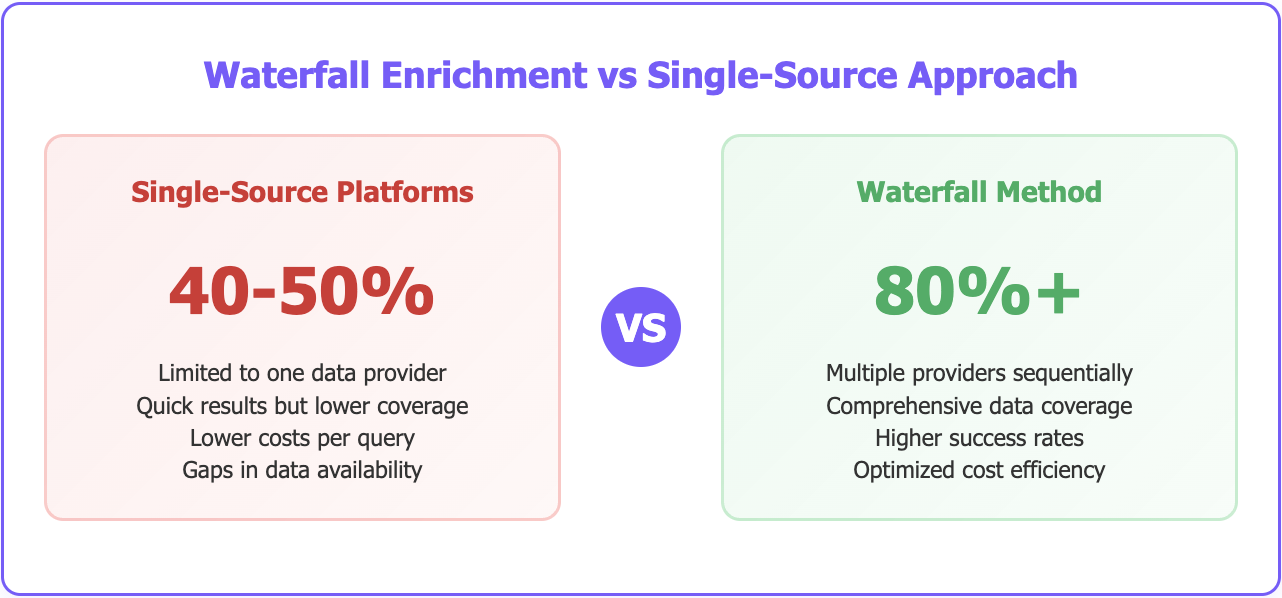
When you need to enrich a lead, the platform doesn't just query a single database. Instead, it follows a hierarchical approach:
Primary Search: Clay starts with the most reliable data source for your specific query type. For email discovery, this might be Hunter or Prospeo. For company data, it could be Owler or People Data Labs.
Sequential Fallback: If the primary source returns no results, Clay automatically queries the next provider in the waterfall sequence. This continues until data is found or all sources are exhausted.
This methodology typically achieves 80%+ match rates for email discovery, significantly higher than single-source alternatives that often plateau around 40-50%.
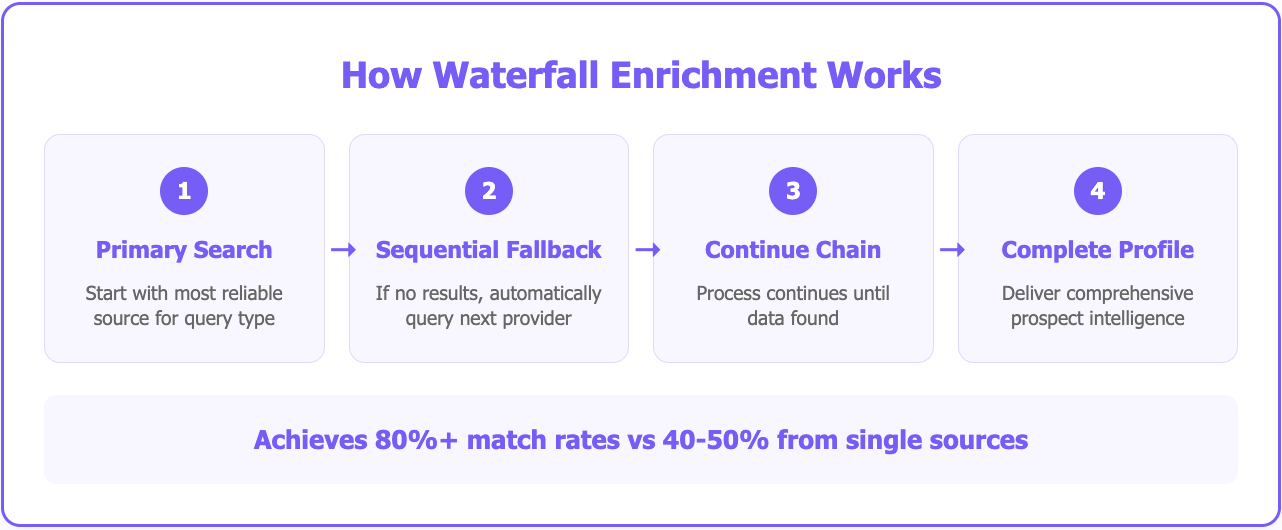
Clay excels in several key areas. Their data coverage breadth through integration with 90+ data providers creates good coverage across different data types. Whether you need technographic data from BuiltWith, firmographic information from LinkedIn, or intent signals from Bombora, Clay aggregates it all through one interface.
The conditional logic power sets Clay apart from basic enrichment tools. You can enrich enterprise prospects with premium data sources while using cost-effective providers for smaller accounts. This flexibility helps optimize both data quality and budget allocation.
Claygent, Clay's AI research assistant, goes beyond traditional lead enrichment by conducting web research, analyzing company websites, and extracting insights that structured databases miss. This capability proves particularly valuable for highly personalized outreach campaigns.
Clay's power comes with complexity. Most users report needing 4-6 weeks to feel truly comfortable with the platform's capabilities. This learning curve includes understanding the credit system and optimizing consumption, building effective conditional logic for different prospect types, mastering the table-based interface and workflow creation, and integrating with existing tech stack while maintaining data flow consistency.
Setting Up Clay's Enrichment Workflows
Understanding Clay's practical operation helps evaluate whether its approach aligns with your team's needs and capabilities.
Clay begins with your existing prospect data, which can come from multiple sources. You might upload a CSV of conference attendees, import contacts from your CRM, or use Clay's built-in company search to identify target accounts. The platform immediately analyzes your data quality, identifying missing fields and potential enrichment opportunities.
Once your data is prepared, Clay's enrichment engine begins working through your specified sequence. The process operates on several levels simultaneously. Contact-level enrichment finds email addresses, phone numbers, LinkedIn profiles, and job title verification. Clay's waterfall approach typically discovers emails for 80%+ of B2B prospects when properly configured.
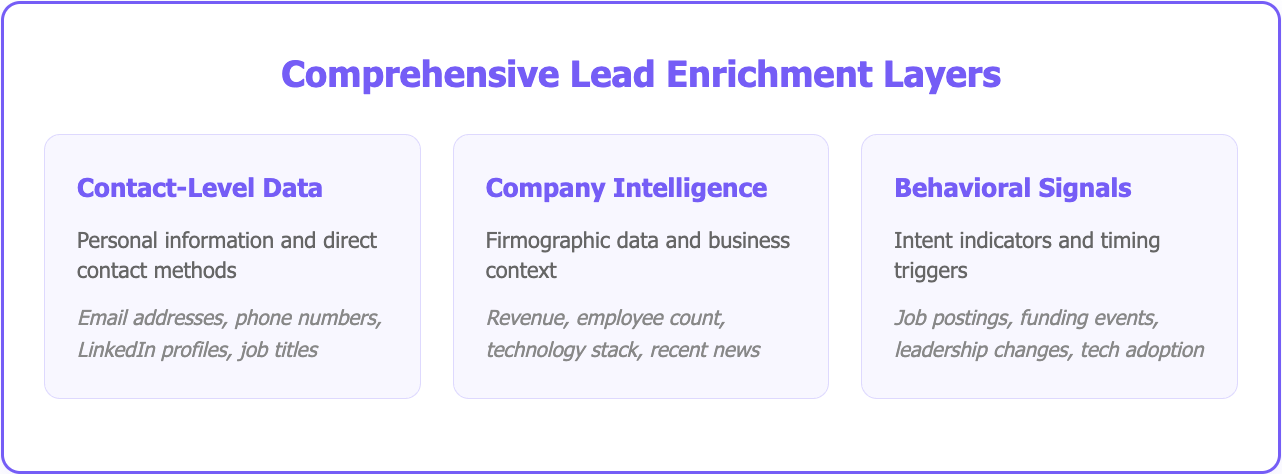
Company-level enhancement adds firmographic data including revenue estimates, employee counts, technology stack information, and recent news or funding events. Advanced signal detection identifies buying intent signals such as job postings in relevant departments, technology changes, leadership updates, or growth indicators.
Clay doesn't just collect data – it verifies accuracy through multiple mechanisms. Email addresses get validated for deliverability, company information gets cross-referenced across sources, and contact details receive freshness scores based on last verification dates. This verification process consumes additional credits but significantly improves campaign performance by reducing bounce rates and ensuring outreach reaches active prospects.
Enriched data doesn't remain isolated in Clay. The platform pushes verified information to your CRM, email automation tools, and other sales systems. You can configure automatic updates, scheduled refreshes, and trigger-based enrichment for new leads entering your funnel.
How Well Clay Actually Performs
Real-world performance data reveals both Clay's strengths and limitations in practical application.
Clay's lead enrichment accuracy varies significantly by data type and source combination. Email discovery performs exceptionally well, with properly configured waterfalls achieving 80%+ match rates. Company firmographic data shows good accuracy for established businesses but struggles with startups and private companies that maintain minimal online presence.
Phone number discovery represents Clay's weakest area, with match rates typically falling between 40-60% for direct dials. This limitation affects teams prioritizing cold calling as part of their outreach strategy.
Clay's credit-based pricing creates variable costs depending on enrichment depth and data source selection. Basic email enrichment costs approximately 2-3 credits per successful match, while comprehensive profile building can consume 15-25 credits per prospect.
Beyond credit consumption, Clay's enterprise features come with steep subscription requirements. CRM integration access requires Clay's $800/month Scale plan, creating a significant barrier for growing teams. Databar.ai provides full CRM connectivity starting at $129/month with our Scale plan - an 84% cost reduction for essential sales workflow integration.
Total Cost Considerations
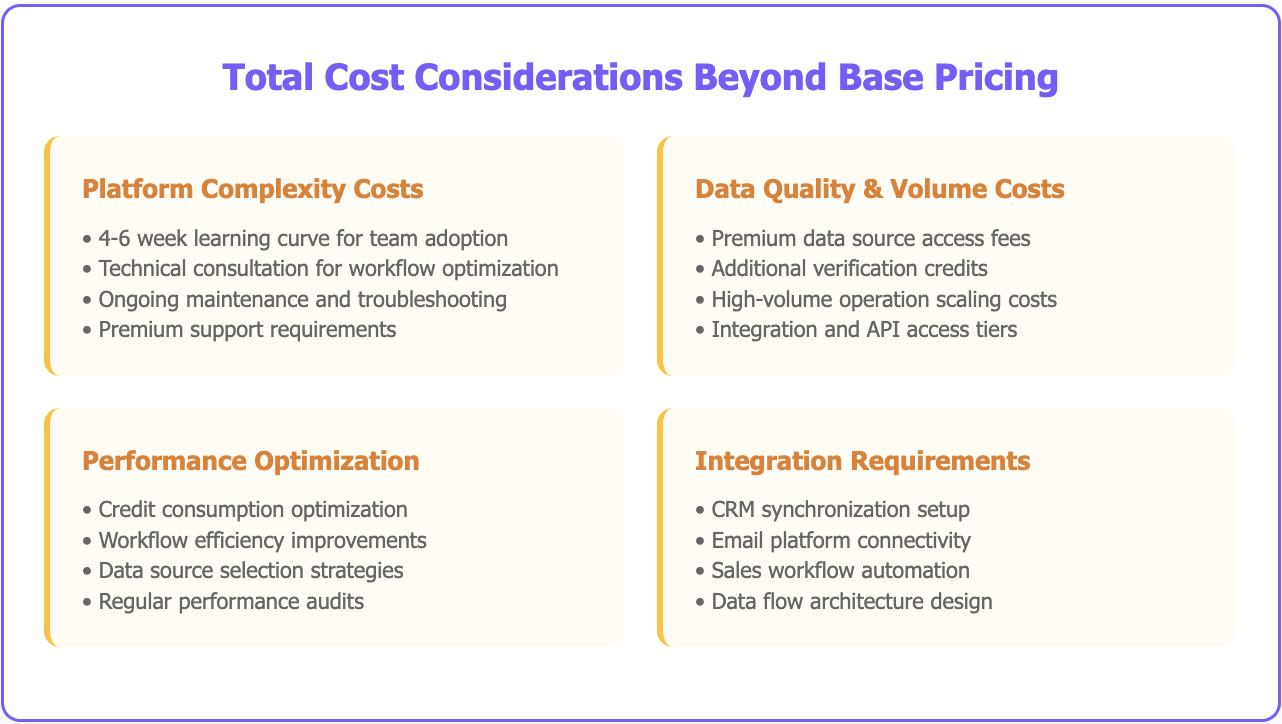
Clay's advertised pricing doesn't include several factors that affect total investment. Teams often discover that effective Clay implementation requires premium data source access, additional verification credits for email deliverability, and technical consultation for workflow optimization. These additional costs can push monthly expenses significantly beyond initial budget expectations. High-volume operations or extensive research workflows can quickly reach $1,000+ monthly in total platform costs.
Clay processes enrichment requests in real-time, with most basic queries completing within 30-60 seconds. Complex research tasks involving Claygent can take 2-5 minutes per prospect. The platform handles large datasets effectively, processing thousands of records simultaneously without significant performance degradation. However, extensive parallel processing can consume credits rapidly, requiring careful workflow optimization.
Common Clay user feedback highlights limited customer support for troubleshooting complex workflows. While Clay maintains a Slack community, users frequently report challenges getting timely technical assistance for implementation issues.
Other Platforms Worth Considering
The lead enrichment landscape offers several compelling alternatives, each with distinct approaches to data acquisition and workflow automation.
Databar.ai
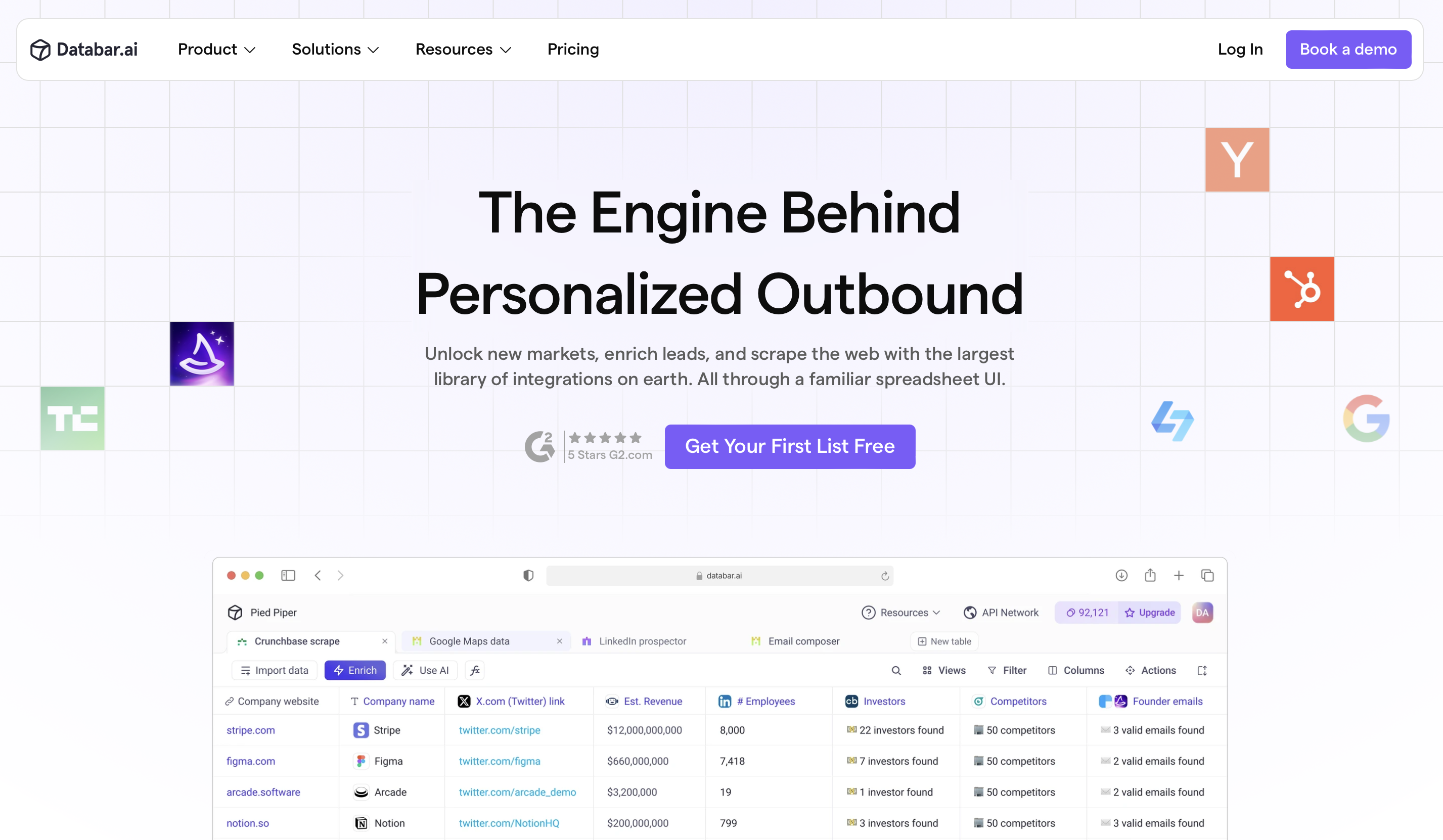
Databar.ai addresses many of Clay's complexity challenges while maintaining comprehensive data coverage. Our platform provides access to 90+ data providers through an intuitive visual interface designed for rapid implementation.
Key differentiators include:
- 5-minute workflow creation vs Clay's typical 2 hour setup process
- Transparent pricing at $0.01 per credit vs Clay's $0.0745
- Advanced integration access at $129/month vs Clay's $800/month requirement
- Responsive customer support with dedicated assistance for implementation
Databar.ai works best for teams seeking powerful enrichment capabilities without Clay's learning curve, organizations prioritizing cost efficiency, and companies needing rapid deployment.
Apollo.io

Apollo.io takes a fundamentally different approach by maintaining its own database of 275+ million contacts while offering integrated outreach capabilities.
Strengths for lead enrichment include immediate access to verified contact data without waterfall delays, built-in email sequencing that eliminates need for separate outreach tools, comprehensive company intelligence including technographic data, and real-time intent signals and buying indicators.
Limitations include limited data coverage compared to other solutions, less flexibility in data source selection, and potential data staleness compared to real-time enrichment.
ZoomInfo
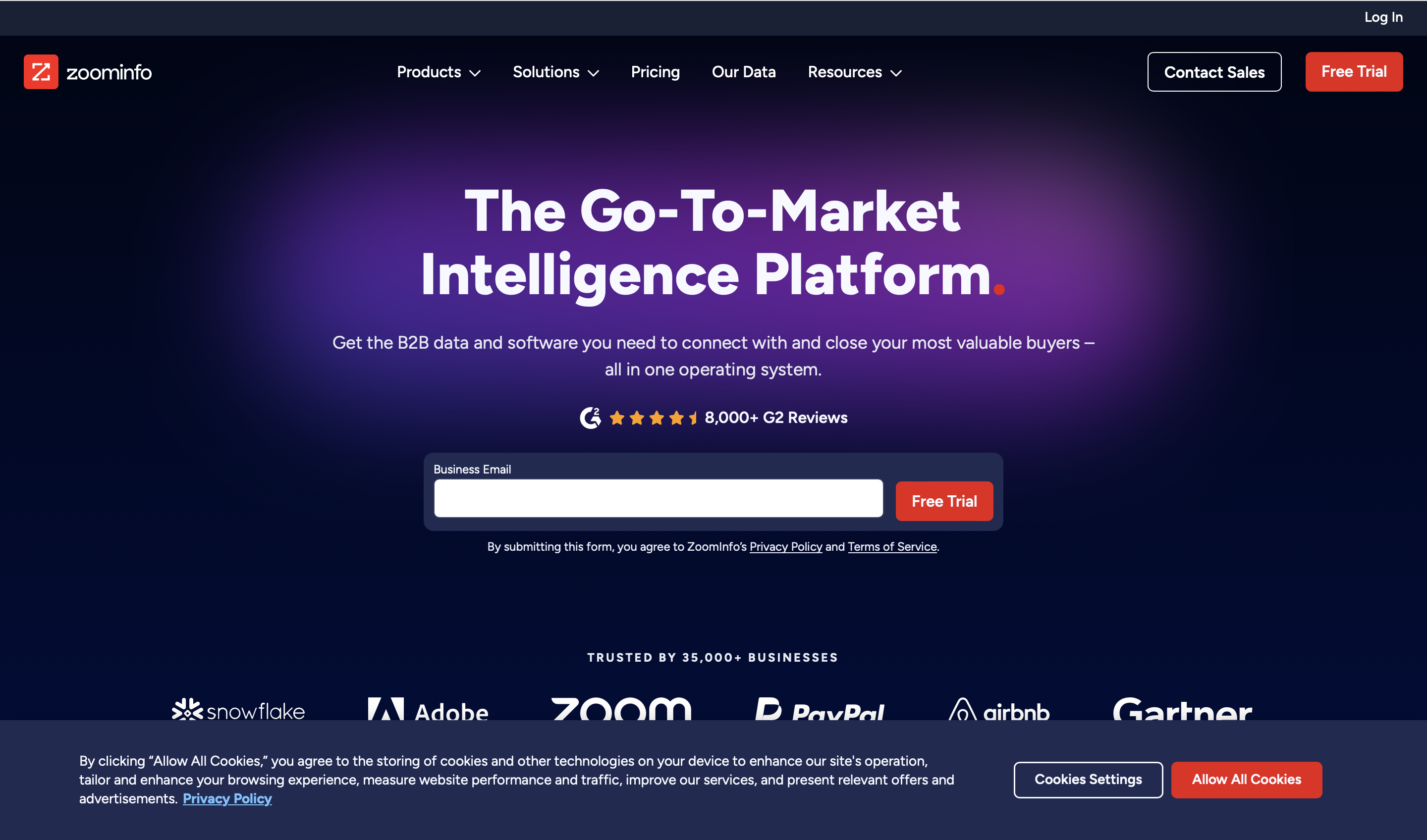
ZoomInfo remains the premium choice for large organizations requiring guaranteed data quality and comprehensive compliance features.
Enterprise-grade advantages include a proprietary database with extensive verification processes, advanced compliance tools for GDPR and CCPA requirements, dedicated account management and custom integrations, and superior accuracy for enterprise contact discovery.
Considerations include significant cost investment starting at $15,000+ annually, complex implementation requirements, and being overpowered for smaller organizations.
FullEnrich
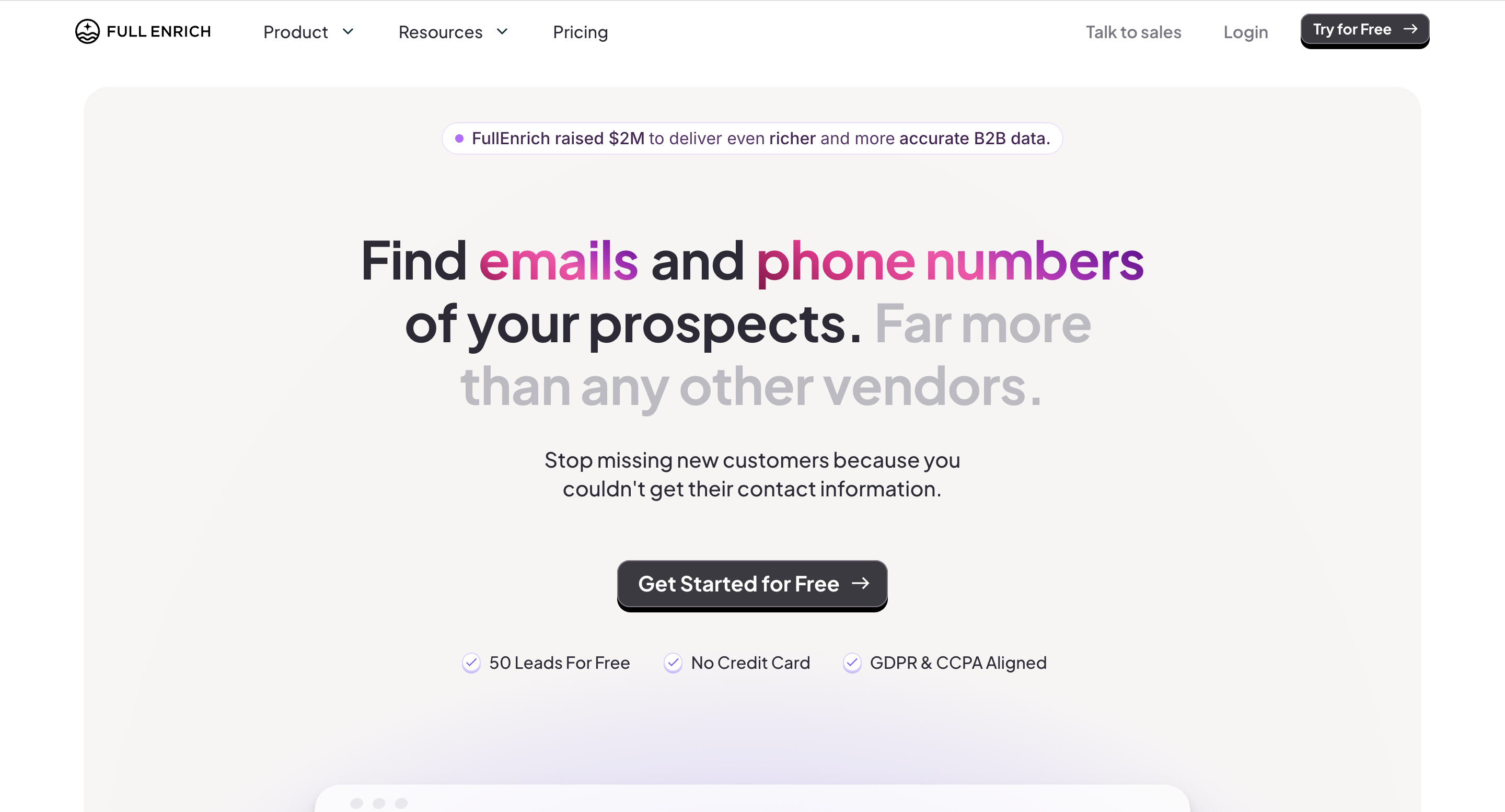
FullEnrich focuses exclusively on contact discovery and verification, providing deep expertise in email and phone number enrichment.
Specialized strengths include triple email verification for maximum deliverability, waterfall approach specifically optimized for contact discovery, seamless integration with existing workflows, and competitive pricing for high-volume contact enrichment.
The ideal use case includes teams with existing research processes needing only contact completion and organizations prioritizing email deliverability over comprehensive data enrichment.
Smart Ways to Use Lead Enrichment
Modern lead enrichment extends far beyond basic contact completion. Successful teams implement sophisticated strategies that combine multiple data signals for comprehensive prospect intelligence.
Rather than enriching all prospects immediately, smart strategies trigger enrichment based on behavioral signals. Website visitors from target accounts get immediate comprehensive enrichment, while cold prospects receive basic contact discovery until engagement indicators appear.
This approach optimizes both cost efficiency and data relevance. Databar.ai's trigger-based workflows make this approach accessible to any team member, while other platforms' complex conditional logic often requires technical expertise and ongoing maintenance.
Lead enrichment becomes exponentially more valuable when connected to revenue attribution. By tracking enriched prospects through the entire sales funnel, teams can identify which data sources and enrichment strategies generate the highest-value opportunities.
Most platforms' integration capabilities support this attribution tracking, though setup requirements and maintenance complexity vary significantly. Databar.ai simplifies this process through native two-way CRM synchronization that keeps enriched data flowing seamlessly to your sales systems.
Advanced teams use lead enrichment to gather competitive intelligence, identifying prospects using competitor solutions and timing outreach around contract renewal periods. This strategy requires specialized data sources and careful verification processes.
Some platforms excel at this type of research-heavy enrichment, though credit consumption can become significant. Alternative approaches using dedicated competitive intelligence tools often provide better cost efficiency for this specific use case.
With evolving privacy regulations, lead enrichment must balance data acquisition with compliance requirements. This involves selective enrichment based on consent status, automated data retention policies, and audit trail maintenance.
Most enrichment platforms provide basic compliance features, but implementation varies significantly. Teams in heavily regulated industries should prioritize platforms with dedicated compliance expertise and established certification processes.
Getting Started the Right Way
Successfully implementing lead enrichment requires systematic planning and staged deployment to achieve optimal results.
Begin by analyzing your current prospect database. Identify missing data fields, assess data quality, and quantify enrichment opportunities. This audit provides baseline metrics for measuring improvement and helps estimate budget requirements.
Document existing prospecting workflows from lead capture to conversion. Identify bottlenecks where better data could improve efficiency or effectiveness. Map integration touchpoints where enriched data needs to flow between systems.
Establish specific, measurable goals for your enrichment program. These might include email deliverability improvements, conversion rate increases, or time savings for sales teams.
Based on your assessment, prioritize essential capabilities versus nice-to-have features. Teams focused on volume typically prioritize speed and cost efficiency, while account-based strategies emphasize data depth and research capabilities.
Design your data flow architecture before selecting platforms. Consider how enriched data will move between systems, what formatting requirements exist, and how you'll maintain data consistency.
Start with a limited scope to test platform performance and team adoption. A 30-day pilot with 500-1,000 prospects provides sufficient data for informed scaling decisions.
Create clear procedures for different enrichment scenarios. Document when to use various data sources, how to interpret enrichment results, and how to optimize for different prospect types.
Establish verification procedures for enriched data, particularly for high-value prospects. Define escalation procedures for data quality issues and regular audit schedules.
Set up dashboards and reporting to track key metrics. Regular review cycles help identify optimization opportunities and ensure continued program effectiveness.
Finding Your Best Option
The optimal lead enrichment approach depends on your specific organizational needs, existing technology stack, and growth objectives.
For high-growth startups, prioritize speed, cost efficiency, and ease of implementation. Databar.ai provides the fastest time-to-value with transparent pricing that scales with growth through its visual workflow builder, comprehensive data coverage, and accessible integration options.
For established sales teams focused on advanced capabilities, customization flexibility, and comprehensive data coverage, Clay offers powerful customization but requires significant implementation investment. Databar.ai delivers similar capabilities with faster deployment and better cost efficiency.
Enterprise organizations needing data quality guarantees, compliance features, and dedicated support should consider ZoomInfo for maximum data quality or Databar.ai for innovative features at enterprise scale. Focus on platforms with robust API capabilities and enterprise-grade security.
Specialized industries requiring industry-specific data sources and compliance should evaluate specialized providers alongside general platforms. Databar.ai's flexible architecture accommodates custom data sources and specialized workflows.
Frequently Asked Questions
How does Clay's waterfall enrichment compare to single-source platforms?
Clay's waterfall approach typically achieves 80%+ email match rates compared to 40-50% from single sources. However, this comes with higher credit consumption and complexity. Databar.ai offers similar waterfall capabilities with more efficient credit usage and simpler implementation.
Can lead enrichment replace sales research teams?
Lead enrichment automates data collection but doesn't replace strategic research and relationship building. It frees sales teams to focus on high-value activities while ensuring they have comprehensive prospect intelligence.
How do I maintain data quality with automated enrichment?
Implement regular verification cycles, use multiple data source validation, and establish feedback loops from sales teams. Databar.ai includes built-in data quality monitoring that alerts teams to accuracy issues.
What integration capabilities should I prioritize?
Focus on seamless CRM synchronization, email platform compatibility, and workflow automation capabilities. Databar.ai offers 1-click integrations with major sales and marketing platforms.
The lead enrichment environment in 2025 offers sophisticated solutions for every organizational need. While various platforms have contributed valuable innovations to the industry, modern solutions must balance comprehensive data coverage with intuitive user experiences and transparent, predictable pricing.
Success in lead enrichment depends less on platform selection than on strategic implementation, consistent optimization, and alignment with broader go-to-market objectives. The platforms that deliver the most value are those that combine powerful data capabilities with accessible interfaces that any team member can master quickly.
Ready to level up your lead enrichment strategy? Try Databar.ai free today and experience the next generation of intelligent prospect data enhancement with transparent pricing, intuitive workflows, and comprehensive data coverage that your entire team can use effectively from day one.
Related articles
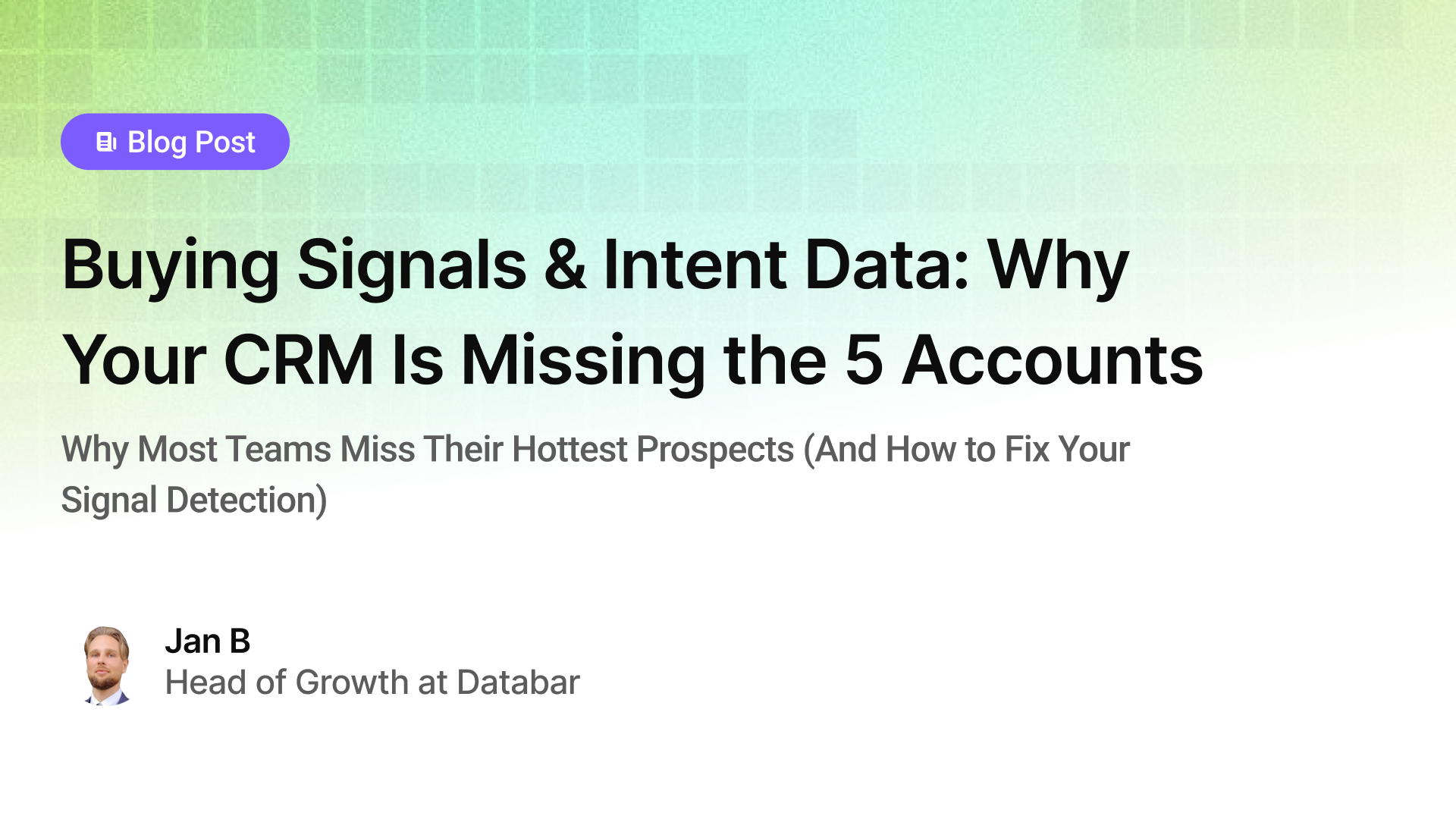
Buying Signals & Intent Data: Why Your CRM Is Missing the 5 Accounts
Why Most Teams Miss Their Hottest Prospects (And How to Fix Your Signal Detection)
by Jan, October 06, 2025

Lead Scoring & Account Segmentation: Why Most CRMs Get This Backward (And How to Fix It)
How to build a system that tells your team who to call, when, and why
by Jan, October 06, 2025
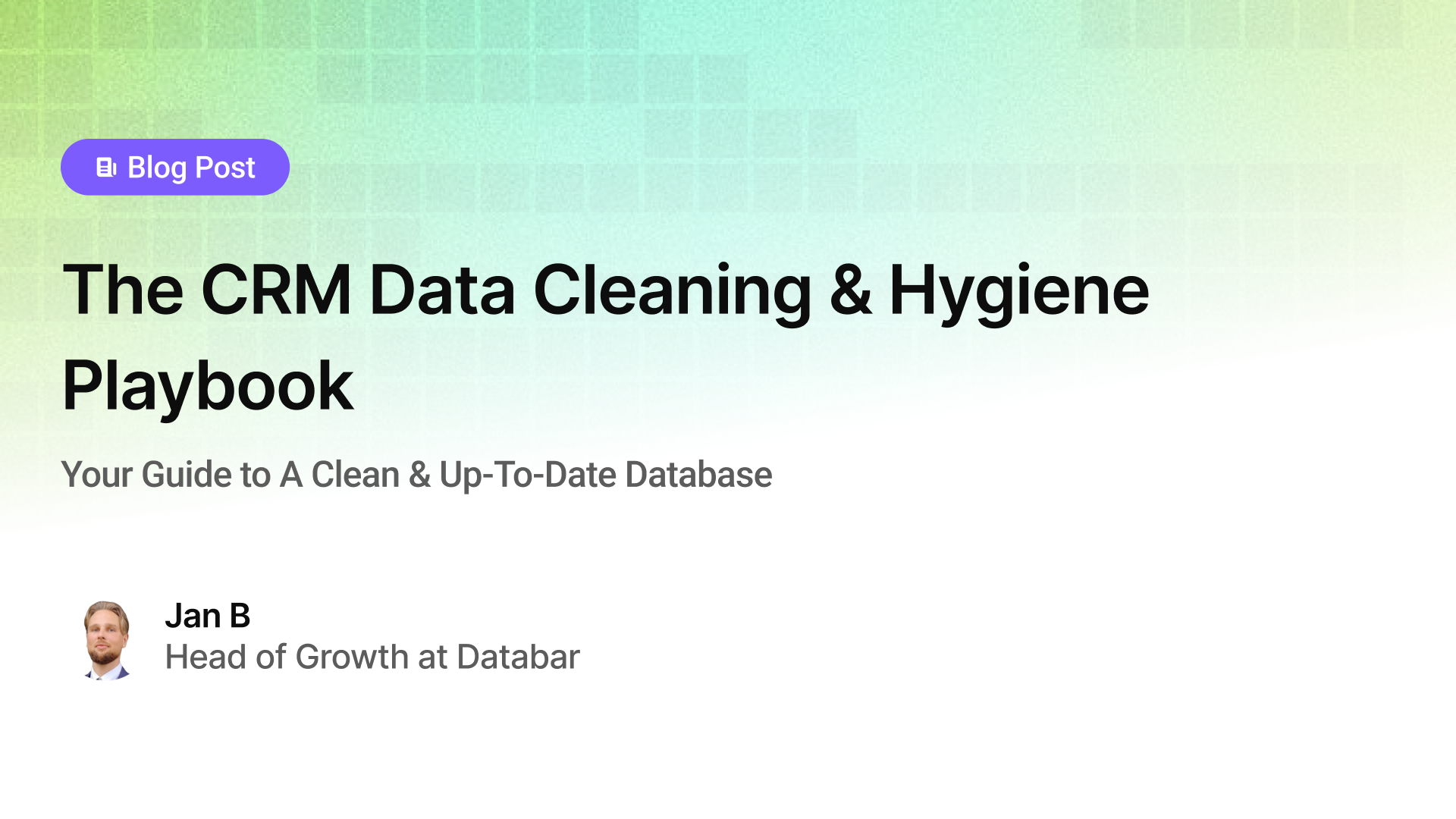
The CRM Data Cleaning & Hygiene Playbook
Your Guide to A Clean & Up-To-Date Database
by Jan, October 04, 2025
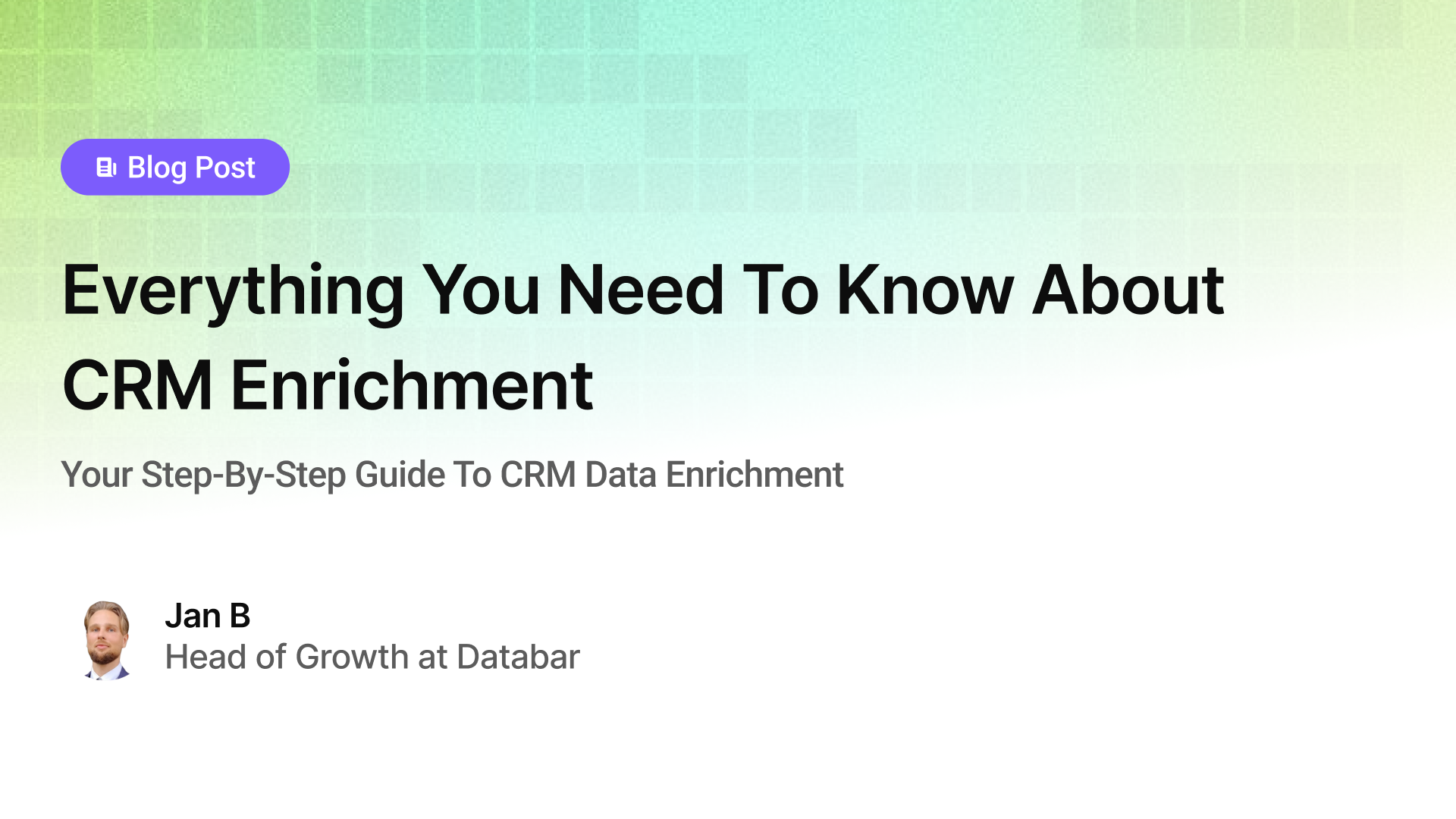
Everything You Need To Know About CRM Enrichment
Your Step-By-Step Guide To CRM Data Enrichment
by Jan, October 03, 2025

